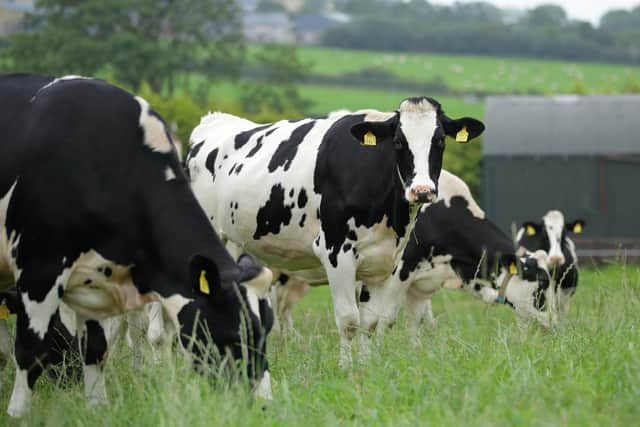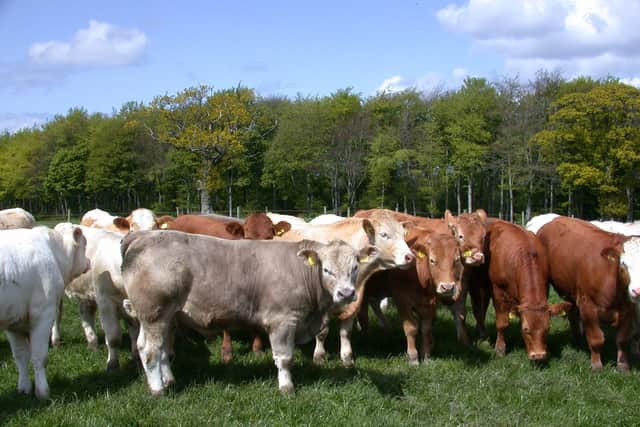The issue of reducing livestock numbers is back on the table
and live on Freeview channel 276
The official document that has been produced to accompany the consultation process makes interesting reading .
Its content will give many farmers cause for concern. In the first instance all its possible options for the future are referenced within the prism of the recommendations published some time ago by the Committee on Climate Change (CCC).
Advertisement
Advertisement
And, specifically, where agriculture is concerned, the CCC pathway includes a proposed reduction of the dairy herd by 22%, a 17% reduction in beef cattle numbers plus a 17% reduction in sheep, pig and poultry numbers.


Adding to this is the fact that the consultation document makes no reference at all to the issue of food security and the role that farming can play in this context.
The only degree of consolation that I gleaned from a recent event on the issue was the assurance given by the DAERA officials in attendance that future emissions targets would be based on net values.
In other words, the carbon sequestration ability of our farms would be fully accounted for in this context.
Advertisement
Advertisement
I am aware that the likes of the Ulster Farmers’ Union (UFU) will be directly briefed by DAERA on these matters.


However, I think it also important that farmers should register their own views on how they perceive agriculture’s role to be as the requirements of the Climate Change Act over the coming months.
DAERA officials are making the point that they are not mandated to follow CCC advice when it comes to setting the required carbon budgets.
And the same principle holds, where the required climate action plan is concerned.
Advertisement
Advertisement
However, the reality is that the current consultation process puts proposed reductions in livestock numbers very clearly back on the public agenda.
This was one of the greatest concerned flagged up by the UFU in the debates held prior to the settlement of the Climate Change Act.
But, as we now know, it’s an issue that hasn’t gone away.
The need for the farming industry to have a strong say in the setting of future carbon budgets and the formulation of Northern Ireland’s Climate Action Plan is very obvious!
Farmers for Action
Meanwhile, Farmers for Action (FFA) is calling for the establishment of a hemp processing facility in Northern Ireland.
The organisation’s William Taylor takes up the story.
“Hemp is the fastest growing form of wood on the planet.
Advertisement
Advertisement
“The crop sequesters more carbon in one year than trees will in 20 years.”
Taylor believes that growing more trees in response to the challenge of climate change is nothing more than a “land grab” away from family farms.
He explained: “Once trees are planted, they are in situ for generations. Food security must be made a priority for farming businesses.
“There is no reason why hemp cannot be included within a standard farming rotation.
Advertisement
Advertisement
“Trees can be planted on ground that is not suited for any other use.”
A deputation from FFA attended one of the carbon budget public consultations, hosted by the Department of Agriculture, Environment and Rural Affairs DAERA)
The organisation’s William Taylor commented: “There would be no need for a reduction of 22% in the dairy herd and 17% reduction in beef numbers due to innovation, which is moving forward at a significant rate of knots.
“We also know that housed cattle when housed will be able to generate electricity whilst eating.
Advertisement
Advertisement
“This is achieved by putting a form of treadmill system into sheds.”
According to the FFA representative cattle can be easily trained to adopt to this type of system. It is hoped that a pilot project will be operational in Northern Ireland within the next two years.
Taylor continued: “For example, if this innovation were in production, then it would mean that by reducing cattle numbers by even one animal, farmers would, in effect, be doing away with one of the greenest forms of energy on the planet.”
He concluded: “We also used the consultation event to highlight our Northern Ireland Farm Welfare Bill.
Advertisement
Advertisement
“This aims to return to farmers a minimum of their cost of production, inflation-linked, plus a margin for their produce.”
Emissions targets and a climate action plan
In March 2022, the Northern Ireland Assembly passed the Climate Change Act (NI) 2022 (the Act), committing the region to an ambitious target of Net Zero emissions by 2050.
With Northern Ireland’s climate ambition now set in law, the next step is to determine the path to Net Zero including the pace of our actions and associated milestones.
According to DAERA, this means setting 2030 and 2040 emissions reduction targets and five yearly ‘carbon budgets’.
Advertisement
Advertisement
These carbon budgets are legally-binding limits on the total amount of greenhouse gases that can be emitted in Northern Ireland for a five-year period and provide a useful way to benchmark Northern Ireland’s progress in meeting climate goals.
The Act places duties on DAERA to prepare and publish a Climate Action Plan to meet a carbon budget and set out how the 2030, 2040 and 2050 emissions reduction targets will be met.
Individual departments are required to provide DAERA with policies and proposals within their area of responsibility for inclusion in the Climate Action Plan.
The intention was to consult on the carbon budgets and the first draft Climate Action Plan (2023-2027) together. However, developing the Climate Action Plan is complex and involves detailed modelling, analysis and policy development across government departments.
Advertisement
Advertisement
Coupled with an extremely difficult budgetary position and the challenges associated with developing, in the absence of ministers, the new policies and programmes that will be required to meet the carbon reduction targets, it will be later this year before the draft Climate Action Plan is completed.
The vision for agriculture
Reductions in methane emissions are given special protections in the new climate change legislation. But major reductions in emissions from agriculture are still necessary.
In the CCC pathway, emissions reductions are to be achieved by: - improved farm productivity; widespread adoption of low-carbon farming practices plus lower livestock numbers with associated agricultural land transitioning to bio-energy cropping and forestry.
DAERA’s current consideration of the CCC Pathway for agriculture is within the context of the policies and proposals contained within the Ministerial decisions on Future Agricultural Policy, announced in March 2022. These are aimed at delivering an agricultural industry with improved productivity, improved resilience, improved environmental sustainability and an effective functioning supply chain. This also includes a focus on reducing carbon.
Advertisement
Advertisement
The CCC Pathway assumes a significant reduction in livestock numbers and an associated transition to significant bioenergy cropping and increased forestry on agricultural land.
The reduction in livestock numbers is based on the assumption that the consumption of livestock products in the UK will fall and that this will lead to an equal reduction in Northern Ireland livestock numbers.
The DAERA perspective
DAERA is conscious of the nature of the Northern Ireland agricultural sector, with very significant markets for livestock products outside the UK.
The Department’s assessment, based on the scenario modelling that has been undertaken by ADAS, is that the policies and proposals within the Future Agricultural Policy Programme can deliver in line with the emissions reductions in the CCC advice pathway for the agriculture sector, over 2023-2027.
Advertisement
Advertisement
The agriculture emission reductions in the first carbon budget will, therefore, be achieved without reductions in the numbers of breeding animals but with a focus on reducing the number of older, non-breeding animals on farm through improvements in animal productivity.
Land released as a result of the reduction in numbers of older, non-breeding animals will be available for alternative land use activities.
New innovations
In order to support an increase in livestock productivity and reduce greenhouse gas emissions, DAERA is developing a Beef Sustainability Package aimed at farms which finish beef cattle and/or have suckler/beef cows.
New innovations in nutrition for livestock have the potential to play a key role to reduce greenhouse gas emissions and improve other environmental considerations (nitrogen and phosphorus losses).
Advertisement
Advertisement
As a first-step, a new research funding programme is under development by DAERA to challenge the agricultural supply industry to lead collaborative research and innovation in nutrition.
Guided by this work, DAERA considers there is potential to increase the uptake of new innovations beyond that assumed in the Pathway.
Ruminant genetics programme
As identified in the CCC pathway, developments in cattle breeding have the potential to sustainably increase the rate of improvements in productivity and directly reduce levels of methane emitted by cattle.
A ruminant genetics programme being developed by DAERA in partnership with the agri-food sector will provide genetic and performance data to help farmers identify and breed from the most productive and environmentally sustainable (i.e. those which produce less emissions) animals.
Advertisement
Advertisement
As recognised in the CCC Pathway, reducing nitrous oxide emissions from inorganic and livestock manures is an important mitigation measure.
Applied research
DAERA is planning new applied research and knowledge transfer initiatives, using information gained from the Soil Nutrient Health Scheme to encourage greater uptake of mitigation measures relating to the type and level of inorganic fertiliser applied.
The ADAS modelled emission mitigation reduction delivered by the policies and proposals amount to over 700 ktCO2 e by 2027 or 12.1% of the agriculture sector emissions in 2020. This is based on modelling assumptions which are stretching and challenging for policy developers, researchers, knowledge transfer and the agriculture industry in Northern Ireland.
In addition to the above, there is the expectation that over the next number of years there will be a major emphasis on science to reduce agricultural emissions which will have significant impact on greenhouse gas emissions towards 2050.
Advertisement
Advertisement
This all points to greater scientific evidence helping to inform new direction for agriculture, with a firm focus on just transition, for the second and subsequent carbon budgets.
In conclusion
DAERA is continuing to work with other Northern Ireland departments to draft Northern Ireland’s first Climate Action Plan covering the period 2023-2027.
The draft Climate Action Plan will be shaped by cross-departmental input on policies and proposals to reduce Northern Ireland’s emissions and deliver effective decarbonisation actions across key sectors.
It will also consider, amongst others, key issues of ‘just transition’, behavioural change, science and evidence, innovation, climate resilience, soil quality, air quality and biodiversity. In developing the draft Climate Action Plan, departments will also assess the impacts associated with the proposed policies and proposals.
Stakeholders’ views on the CCC advice report gathered as part of this process will help inform the development of the Climate Action Plan.